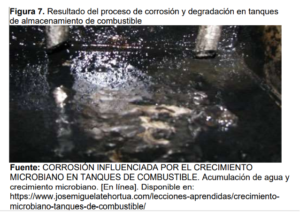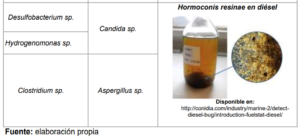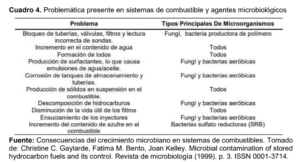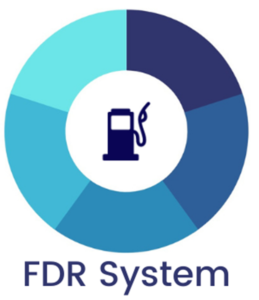Current fuel disinfection, cleaning and recycling systems are based on biocidal agents, which are inefficient and costly for the results obtained.
This patent will build a machine that has the ability to clean, disinfect and recycle fuel contained in hydrocarbon tanks (machines, cars, ships and fuel tanks of distributors). It will also be able to remove chemicals and dyes additionally contained in the fuel.
Needs covered
The fuel storage tanks over the years and because of the humidity of the environment accumulate a layer of water at its base that causes it to generate a series of microorganisms that develop and proliferate resulting in a dense and filamentous algae that in the best case clogs the engine filters and stops the engine. These microorganisms are corrosive and damage the tank that contains them, even perforating it, it goes without saying that this is critical in a boat.
In addition to this, there are dirty fuels. What do we mean when we talk about dirty fuels? Well, gas oils or gasolines that have an excess of sulphur particles, dust and other polluting substances.
The effects of dirt in fuels are obvious: all those elements floating in the diesel are a danger for the engine: they can damage the engine and other important parts such as the injectors.
Types of fuels affected by microbial contamination in tanks:
- Díesel
- Biodiesel
- Fuel oil or fuel oil (heavy fuel oils).
The present invention covers the need to solve this problem in an easy, definitive, economical and efficient way, since the solutions proposed up to now do not meet any of these characteristics.
Sector to which the patent is addressed
All sectors with hydrocarbon deposits, as these suffer degradation and contamination, which can cause serious problems when used in ships, trains, trucks, stand-by generators, etc.
Fuels stored for long periods of time can suffer from polymerization, oxidation, emulsions, bacterial and fungal contamination. These problems can form residues and gums. Aging of these fuel residues and gums can cause serious problems in engines and fuel systems.
Sectors:
- Shipbuilding industry, pleasure boats, ferries and cargo ships. The tanks of the ships have medium-sized problems with water accumulation on the surface of the ships.
- Service Stations (SDS). The tanks are buried in the ground and it is easy for moisture to accumulate there.
- Companies engaged in the storage, transportation and distribution of fuel. Microbes are present in fuel and crude oil storage tanks causing serious and costly bio-deterioration damage to inventories and infrastructure.
Bacteria and fungi can grow and develop in crude oil and fuel storage tanks. Biologically contaminated storage tanks experience quality and infrastructure related problems. Microbial contamination problems that affect vehicle performance include slime build-up, blockage of filters, injectors, product discoloration, sludge, tank and pipe corrosion, emulsification and mixing of fuels with water, and costly fuel quality degradation.
- Automotive. Vehicles that drive in areas with high humidity suffer from this problem, especially if they remain unused for a long time.
Fuel storage tanks
- Features
Currently, fuel storage tanks are commonly manufactured in fiberglass, there are tanks made of rustproof materials such as steel, aluminum or pvc, however, since the problems caused by the use of fuel stations have been forced to use linings of composite materials reinforced with fiberglass for its greater resistance to aggressive media or a change of tank.
All fiberglass tanks are constructed of FRP (fiberglass reinforced plastic). The corrosive barrier of this kind of tanks is built with polyester resin for the storage of fuels with alcohol mixtures ranging from 30% to 100%. These tanks are compatible for storage of materials such as gasoline, diesel oil and gasoline-alcohol blends.
- Microorganisms in fuel storage tanks
The presence of microorganisms in fuels has become a problem that has directly affected the industry since the first signs of microbial growth began to be observed inside storage tanks because they use petroleum hydrocarbons or refined fuels as a carbon source for their growth and proliferation. This generates biological wear on the surface of the tanks, as well as biodegradation and biocontamination of the fuels as shown in Figure 6 and Figure 7.
The most commonly encountered microorganisms are bacteria, molds and yeasts. Pseudomonas are the genus most frequently isolated from contaminated environments; they are known for their ability to grow on a wide variety of petroleum hydrocarbons such as benzene, naphthalene and toluene (gasoline and diesel). Most of the hydrocarbon degrading bacteria are found in the gram negative group; the lipopolysaccharides present in their membranes help the formation and stabilization of hydrocarbon emulsions in aqueous systems and contribute to the increase in the attack surface on the contaminant.
Sulfate-reducing bacteria (SRB), both aerobic and facultative anaerobic organisms, are also found. Table 3 below shows the most common types of microorganisms that can be found in fuels.
 The main factors that favour the reproduction of microorganisms in fuels are water (quantities equal to or less than 0.5% are required), sulphur reduction, oxygen content and the availability of minerals such as phosphorus and nitrogen, as well as the presence of biofuels (B10, E10) due to their hygroscopic nature.
The main factors that favour the reproduction of microorganisms in fuels are water (quantities equal to or less than 0.5% are required), sulphur reduction, oxygen content and the availability of minerals such as phosphorus and nitrogen, as well as the presence of biofuels (B10, E10) due to their hygroscopic nature.
With respect to storage tanks, microorganisms can lodge inside, adhering to the wall surface, where a polysaccharide matrix forms a biofilm generally composed of bacteria and fungi (Wall-Liquid phase). These biofilms provide protection and a unique environment for the development of microorganisms.
Microorganisms can also lodge at the bottom of the tank, where a fuel-water interface is generally formed, where the microorganisms increase the water content by excreting polysaccharides that act as extracellular biosurfactants. Likewise, the metabolic activity leads to the formation of peroxides and acids, which decrease the thermal stability and volatility of the fuel, as well as the increase of suspended solids and corrosion residues.
Table 4 below summarizes the problems that can occur in fuel systems and the microbiological agents responsible.
 Crude oil and its by-products contain nutritious components, which also favor the metabolic activity of microorganisms, which not only accelerate the biodeterioration of fuels and their additives, but also damage the physicochemical and operational properties of the product, leading to economic losses and even incidents due to the saturation of filters, pipes and corrosion of equipment.
Crude oil and its by-products contain nutritious components, which also favor the metabolic activity of microorganisms, which not only accelerate the biodeterioration of fuels and their additives, but also damage the physicochemical and operational properties of the product, leading to economic losses and even incidents due to the saturation of filters, pipes and corrosion of equipment.
Symptoms of microbial contamination of diesel fuel:
- Biomass aggregation observed as discoloration, turbidity and fouling.
- Biosurfactants promote water turbidity and particle dispersion affecting plug filters, pumps and injectors.
- Stings in the tank.
- Non-uniform fuel flow and combustion variations can accelerate piston and cylinder ring wear rates and affect camshaft torque.
- Current technologies for the prevention of microorganisms in fuel tanks
Currently there are a wide variety of qualitative methods that allow the detection of microorganisms specifically in fuels in a quick and easy way, since they do not require much sample preparation; it should be noted that when evaluating microbiological contamination in the fuel, the aqueous phase present at the bottom must be taken into account, since it is where the highest microbial load will be found[1]. Generally, one of the best treatments for the control and mitigation of microorganisms in fuels are good housekeeping practices, such as cleaning inside the tank and periodic water drains. However, it is difficult to perform this type of cleaning on a regular basis, as it involves high costs, in addition to the loss of sales per cleaning days per year.
 It should be noted that this type of maintenance is considered high risk due to tank degassing, disconnection of electrical and pneumatic systems, among others. For this reason, this type of maintenance should be performed as a complement to a microbiological control. Among the methods used by the ESD to combat background problems and microbiological contamination we can find the following:
It should be noted that this type of maintenance is considered high risk due to tank degassing, disconnection of electrical and pneumatic systems, among others. For this reason, this type of maintenance should be performed as a complement to a microbiological control. Among the methods used by the ESD to combat background problems and microbiological contamination we can find the following:
- Microfiltration equipment. They are systems that are installed before the pump, in order to filter the fuel that comes out of the storage tank and that the consumer receives in his vehicle. They have filters of between 3 and 5 microns, which ensures a wide retention of contaminating particles.
- Tank cleaning. Also called dialysis, it consists of the recirculation of the fuel located at the bottom of the tank, using a probe. This probe extracts the fuel from the bottom, passes it through a series of filters, which retain the different contaminants. Finally, the clean fuel is returned to the storage tank.
These methods do not ensure the removal of bio-films adhering to the walls of the storage tank or the reduction of microbiological load in the fuel. They are generally used to improve the appearance of the fuel at the bottom of the tank or to remove possible water deposits.
In our case, we incorporate elements that disinfect the fuel and when it is returned to the tank it is done in such a way that it drags all the impurities and microorganisms, so that in the time that lasts the process of action of the machine all have been filtered and pass through the disinfection chamber of our machine.
 The quality of the disinfection process must be emphasized, in which no additives or biocides have to be added to the fuel and the quality of the fuel is not degraded in the process.
The quality of the disinfection process must be emphasized, in which no additives or biocides have to be added to the fuel and the quality of the fuel is not degraded in the process.
- Prevention of the presence of microorganisms in fuels using biocidal agents.
Biocidal products are "substances capable of eliminating or controlling the proliferation of microorganisms capable of causing alterations in humans, animals and the environment. The different chemical families of biocidal compounds have different profiles of action, but they all share the characteristic of being lethal to microorganisms under a certain set of circumstances that make them viable for marketing", but has the following problems:
- They do not have the same ability to mitigate the concentration of microorganisms in both the aqueous phase and the fuel.
- They usually have a limited spectrum of microbial activity.
- It has an inhibitory effect in the presence of other substances.
- Often corrosive in fuel systems.
- Degrades fuel properties.
- They are generally not safe for both human use and the environment.
- High cost. Approximate price of about 50 € per 1,000 liters of fuel.
- It forces you to use it indefinitely once the problem has appeared.
But the main problem is that they do not solve the problem definitively because if a small amount of microbial residue remains, it will reproduce over the months. That is why it is essential to maintain it indefinitely in case of a first detection of microbes.
- Preventing the presence of microorganisms in fuels using Disinfection with biocides
Disinfection by dosing with a biocidal agent presents the following difficulties:
- It is not possible to use them in all tanks, due to their morphology and location.
- The cost depends very much on the difficulty of access to the tank. For example, it is 30,000 € on average for a boat with a tank of 10,000 liters of fuel (The cost: 15,000 € for removal of contaminated fuel and transfer to a recycling station, 5,000 € for cleaning the tank and filters, and 10,000 € for refueling).
The standard boat of the study is a boat with a tank of 10,000 liters of fuel, which corresponds to an average boat within the recreational boating. For this boat is the one for which we have calculated the retail price of a machine at 5,000 €.
1] GAYLARDE Christine, BENTO Fatima, KELLEY Joan. Microbial contamination of stored hydrocarbon fuels and its control. In: Journal of microbiology. February 1999. Vol 30, no 1, p. 01- 10. ISSN 0001-3714

